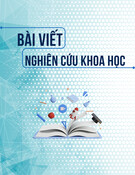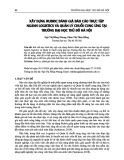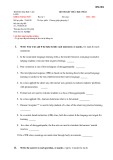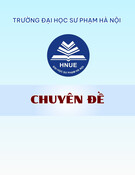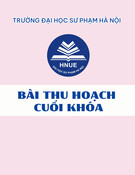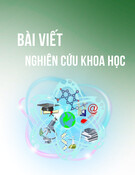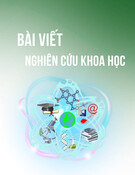
P-ISSN 1859-3585 E-ISSN 2615-9619 https://jst-haui.vn LANGUAGE - CULTURE Vol. 60 - No. 10 (Oct 2024) HaUI Journal of Science and Technology
77
FORMATIVE ASSESSMENT PRACTICES IN ENGLISH FOR OCCUPATIONAL PURPOSES CLASSROOMS: A CASE STUDY AT A UNIVERSITY IN VIETNAM
THỰC HÀNH ĐÁNH GIÁ QUÁ TRÌNH CỦA GIẢNG VIÊN TRONG LỚP HỌC TIẾNG ANH ĐỊNH HƯỚNG NGHỀ NGHIỆP: NGHIÊN CỨU TẠI MỘT TRƯỜNG ĐẠI HỌC Ở VIỆT NAM Nguyễn Thị Điệp1,*, Tôn Quang Cường2 DOI: http://doi.org/10.57001/huih5804.2024.327 ABSTRACT Assessment can be considered as a key
component for the improvement of the quality of language teaching and learning process. This study aims to
investigate how teachers practice formative assessments (FA) in English for occupational purposes (EOP) classes and how they perceive it in promoting
students’
learning, as well as challenges they faced. Data were collected through survey questionaires with sixty-
one teachers and interviews with five teachers selected
randomly. The findings indicated that teachers used various strategies of FA in EOP c
lassroom and perceived FA had positive impacts to students’ learning.
However, the results revealed the majority of teachers had challenges with time constraints and a big number of students in a
n EOP class while implementing
FA activities. The findings of this research was a significant contribution for enhancing the effectiveness of the implementation of FA strategies in langua
ge
teaching & learning, particularly in EOP context. Through the research, some recommendations are suggested to improve the effec
tiveness of the
implementation of FA in EOP classrooms as well as the quality of overall EOP courses at Hanoi University of Industry (HaUI). Keywords: Formative assessment, strategies, impacts, challenges, assessment. TÓM TẮT Đánh giá có thể được coi là một yếu tố quan trọng trong việc cải thiện chất lượng dạy và học ngoại ngữ. Nghiên cứu này nhằm mục đích tìm hiểu về việc thự
c
hành đánh giá quá trình trong lớp học tiếng Anh định hướng nghề nghiệp của giảng viên cũng như nhận định của họ về tác động của đánh giá quá trình với việ
c
học của sinh viên và những khó khăn họ gặp phải trong quá trình thực hiện. Dữ liệu của nghiên cứu được thu thập thông qua bảng câu hỏi khảo sát với 61 giả
ng
viên và phỏng vấn 5 giảng viên được chọn ngẫu nhiên từ những người tham gia khảo sát. Kết quả cho thấy, giảng viên sử dụng nhiều chiến lượ
c đánh giá quá
trình khác nhau trong lớp học EOP, cũng như nhận thấy đánh giá quá trình có tác động tích cực đến việc học của sinh viên. Nghiên cứu cũng chỉ ra hạn chế về mặ
t
thời gian và số lượng sinh viên trong lớp đông là hai khó khăn mà đa số giảng viên gặp phải trong quá trình thực hiện đánh giá quá trình. Kết quả củ
a nghiên
cứu sẽ là một đóng góp ý nghĩa cho việc nâng cao hiệu quả của việc thực hiện đánh giá quá trình trong việc dạy và học ngôn ngữ, đặc biệt là trong lớp học tiế
ng
Anh định hướng nghề nghiệp. Thông qua nghiên cứu, một số khuyến nghị được đề xuất để nhằm giúp cải thiện hiệu quả của việc thực hiện đánh giá quá tr
ình
trong các lớp học tiếng Anh định hướng nghề nghiệp cũng như nâng cao chất lượng của toàn khóa học tiếng Anh định hướng nghề nghiệp ở Trường Đại họ
c Công
nghiệp Hà Nội. Từ khóa: Đánh giá hình thành, chiến lược, tác động, thử thách, đánh giá. 1School of Languages and Tourism, Hanoi University of Industry, Vietnam 2University of Education, Vietnam National University, Hanoi, Vietnam *Email: diepnt.haui@gmail.com Received: 10/9/2024 Revised: 22/10/2024 Accepted: 28/10/2024






